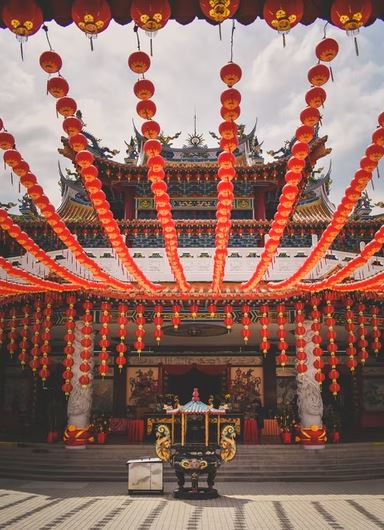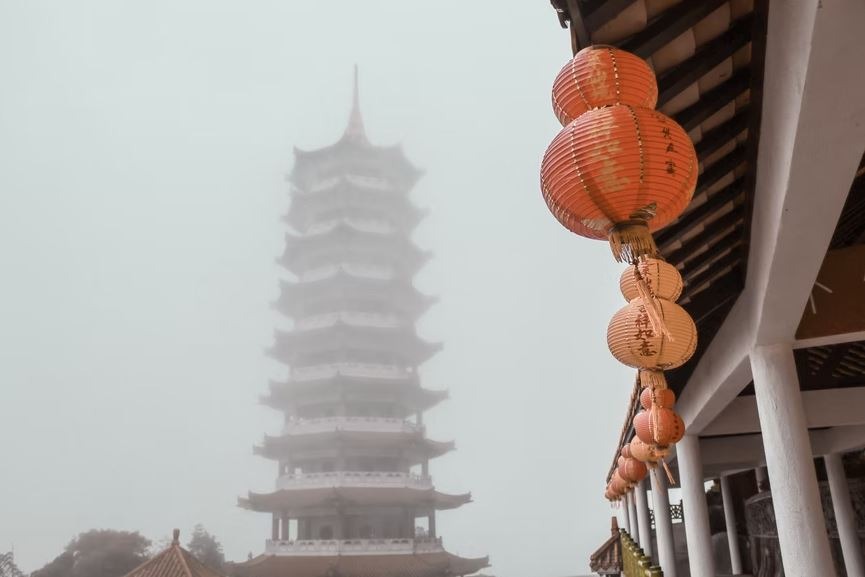The daily rituals and religious celebrations of the Buddhist and Hindu communities take place at the temples in Malaysia. Each temple is devoted to its ancestors and holy deities and has a distinct architectural style and history. Aside from the Citrus Hotel, Johor Bahru of Malaysia, there are a lot of temples to see and visit. Here is a list of Malaysia’s most impressive temples so you can start visiting them.
Temples To See in Malaysia
1. Batu Caves Temple
Hindu devotees frequently made their way to the Batu Caves Temple to pray. The holy shrine, which is devoted to Lord Murugan, is where they also celebrate Thaipusam together. The temple is situated within the limestone hills of the Gombak (40 minutes train ride from Kuala Lumpur). A flight of 272 steep stairs leads up to the caves, where a towering golden statue of Lord Murugan stands guard. The largest cave in this sacred area is called Temple Cave, and there are a few smaller ones as well. Ornate Hindu statues, shrines, and paintings depicting the tales of how Lord Murugan vanquished the demon Soorapadan can be found in each cave.
2. Kek Lok Si Temple
At the peak of Penang Island’s hills is the elaborate 19th-century Buddhist temple known as Kek Lok Si Temple. Numerous hundreds of exquisitely detailed carvings, sculptures, and murals, as well as millions of beautiful images of Buddha, are used to decorate the interior and exterior of temple halls, pagodas, and archways. Significant meanings from Chinese culture and Buddhist teachings are conveyed through the intricate architectural designs. There is an outdoor temple garden where visitors can stroll while admiring the stunning temple, which includes the three-tiered Kek Lok Si Pagoda with its distinct Buddhist architectural style. When visiting this temple, you must also try the top foods of Malaysia.
3. Sri Mahamariamman Temple
Hindu devotees flock to the Sri Mahamarianmman temple, which is located along Jalan Tun HS Lee. 228 sculpted Hindu deities representing scenes from the Ramayana decorate the five-tiered temple entrance. The temple is embellished with Hindu symbols that tell the history of early Hinduism. The three main shrines and the main prayer hall each have a decorated ceiling. The main prayer hall is surrounded by four tiny shrines. Lord Ganesha, Lord Muruga, Lakshmi (Goddess of Wealth), and other gods and goddesses have homes in these shrines. At the top right of the main prayer hall, you will see The Silver Chariot, which is dedicated to Lord Murugan and has 240 bells and two horses.
4. Thean Hou Temple
Thean Hou Temple, a Buddhist structure with six levels, is also referred to as the Temple of the Goddess of Heaven. It serves as a shrine where devotees can offer prayers to Guan Yin, the Goddess of Mercy. The temple features intricate representations of Buddhism, Taoism, and Confucianism in addition to modern architectural features and ornate carvings from earlier periods. Admire the temple’s pagoda rooftops, columns with dragon designs, and grand entrance with red pillars. Explore the contemporary Buddhist pagoda and the octagonal hall housing Buddha statues. Visit the Chinese Herb Garden and unwind by the Tortoise Pond.
5. Khoo Kongsi Temple
One of Penang’s most recognizable landmarks and a symbol of the Hakka people is the Khoo Kongsi Temple. The temple was constructed in the 19th century and is decorated with murals and stone carvings of dragons, carps, deities, and divine guardians. Chinese families with surnames congregate there to pay homage to their ancestors. An association house, a traditional theater, and rowhouses for the clan members gathered at a granite-paved square are still part of the temple’s distinctive past. The temple is situated in the center of historic Georgetown at Cannon Square.
6. Snake Temple
The 1950-built Snake Temple pays homage to Buddhist healer and priest Choo Soo Kong. Legend has it that the priest gave refuge to the jungle snakes, who are said to have become the priest’s followers. These snakes moved into the temple after he died and made it their home. As you enter the temple, you will see a large incense burner in the center of the temple hall with carved and sculptured statues. A snake pool and fruit trees covered in snake coils are located behind the temple.
7. Arulmigu Balathandayuthapani Temple
In Georgetown, Penang, there is a temple called Arulmigu Balathandayuthapani, also called the Waterfall Hill Temple or Hill Top Murugan Temple. According to an ancient myth, a holy man chose the location for the Lord Murugan shrine close to the waterfall. To get to the temple, visitors must ascend 513 steps. It is also a holy shrine where Hindu devotees congregate to perform daily rites and celebrate Thaipusam. The hilltop temple has a gopuram with seven stories and is decorated with statues of gods. The pillared outer hall is typically where public rituals are carried out.
8. Sam Poh Tong Temple
Ipoh’s Gunung Rapat contains a limestone hill where Sam Poh Tong Temple is situated. With numerous Buddhist statues scattered among stalactites and stalagmites that naturally occur, it is a magnificent temple of art and faith. Explore the exquisitely decorated pavilion and the stunning landscape garden with its fish pond. This serene location was honored as Malaysia’s “Best Landscape Gaden” in 1993. Views of Ipoh and the area around the temple will astound you as you ascend the 246-step staircase. Feed the turtles at the pond and make a wish at the wishing well for good luck.
9. Ling Sen Song Temple
At the base of a limestone hill in Ipoh, Perak, there is a Taoist cave temple called Ling Sen Tong Temple. The name means “rock of heavenly spirits” in the translation. Along Jalan Gopeng, it is immediately adjacent to the Sam Poh Tong Temple. Numerous designs, including animals, gods, and other figures from Chinese folklore, can be seen throughout the temple. Chinese mythology is represented by colorful statues, including the legendary Monkey King from the well-known classic story Journey to the West.
10. Chin Swee Cave Temple
On a rocky incline not far from the top of Genting Highlands Resort is Chin Swee Cave Temple. For devotees to pray to the Buddha and the Goddess of Mercy, a temple is a sacred location. Explore this religious temple to learn about the core of Chinese customs and beliefs. Discover the famous nine-story pagoda, which is illuminated by 10,000 lamps of blessing that followers and Buddha statues have placed there. Enjoy the gentle cool breeze and the breathtaking panoramic views of Genting Highlands from the observation deck.


